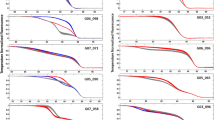Summary
The linkage relationship of a nuclear male sterile locus, ms-10, was tested with two enzyme marker loci known to be on the same chromosome (long arm of chromosome 2). The results indicate the gene order is Est-1 — 18 cM — Prx-2 — 1.5 cM — ms-10. The linkage intensity of ms-10 and Prx-2 (1.5 cM) suggests that Prx-2 might provide a selectable marker for male-sterility. In accordance with this idea, the ms-10 allele was placed in cis with a rare-allele of Prx-2 (Prx-2 1). Selection on the basis of the codominant Prx-2 1 allele should allow for more rapid and efficient transfer of the recessive male sterile allele into an array of genetic backgrounds, thus promoting its use in hybrid seed production.
Similar content being viewed by others
References
Allard RW (1956) Formulas and tables to facilitate the calculation of recombination values in heredity. Hilgardia 24:235–278
Butler L (1977) Summary of gene linkage on chromosome 2. Rep Tomato Genet Coop 27:9–10
Butler L, Rick CM (1953) Additional data on the linkage relations of ms-10. Rep Tomato Genet Coop 3:8–9
Durand Y (1981) Relations entre les genes marqueurs aa et W 0 et le géne de stérilité male ms-35. Génétique et sélection de la tomate. EUCARPIA, Avignon, France, pp 225–228
Larson RE, Paur S (1948) The description and inheritance of a functionally sterile flower mutant in tomato and its probable value in hybrid seed production. Proc Am Soc Hortic Sci 52:355–364
Philouze J (1974) Gènes marqueurs liés aux gènes de stérilité male ms-32 et ms-35 chez la tomate. Ann Amelior Plant 24:77–82
Rick CM (1948) Genetics and development of nine male-sterile tomato mutants. Hilgardia 18:599–633
Rick CM (1952) Linkage of ms-10 with dl in linkage group I. Rep Tomato Genet Coop 2:8
Rick CM (1960) Linkage between ms-10 and Wo m. Rep Tomato Genet Coop 10:3–64
Rick CM, Boynton JE (1967) A temperature-sensitive male-sterile mutant of the tomato. Am J Bot 54:601–611
Rick CM, Fobes JF (1974) Linkage relations of some isozyme loci. Rep Tomato Genet Coop 27:22–24
Rick CM, Tanksley SD, Fobes JF (1979) A pseudoduplication in Lycopersicon pimpinellifolium. Proc Natl Acad Sci USA 76:3435–3439
Rick CM, Zobel RW, Fobes JF (1974) Four peroxidase loci in red-fruited tomato species: genetics and geographic distribution. Proc Natl Acad Sci USA 71:835–839
Schmidt H, Schmidt V (1981) Untersuchungen an pollensterilen, stamenless—ähnlichen Mutanten von Lycopersicon esculentum Mill. 2. Normalisierung von ms-15 und ms-33 mit Gibberellinsäure. Biol Zentralbl 100:691–696
Tanksley SD (1983) Molecular markers in plant breeding. Plant Mol Biol Rep 1:3–8
Tanksley SD, Rick CM (1980) Isozymic gene linkage map of the tomato: applications in genetics and breeding. Theor Appl Genet 57:161–170
Author information
Authors and Affiliations
Additional information
Communicated by A.L. Kahler
Rights and permissions
About this article
Cite this article
Tanksley, S.D., Rick, C.M. & Vallejos, C.E. Tight linkage between a nuclear male-sterile locus and an enzyme marker in tomato. Theoret. Appl. Genetics 68, 109–113 (1984). https://doi.org/10.1007/BF00252324
Received:
Issue Date:
DOI: https://doi.org/10.1007/BF00252324




